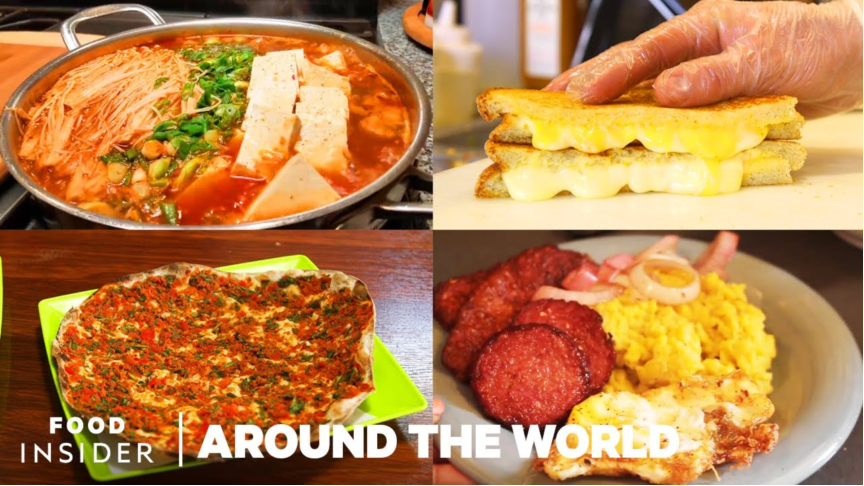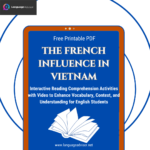Comfort food from around the world. Interactive Reading Comprehension Activities with Video to Enhance Vocabulary, Context, and Understanding for English Students. Free Printable PDF
Comfort food from around the world

Improving reading comprehension is a vital skill for English learners at all levels. It goes beyond just understanding the words on the page, but also involves grasping meaning, context, and intent behind a text. One effective way to enhance reading comprehension is by integrating videos alongside written exercises. Video content can provide visual cues, context, and engagement that help reinforce the learning process. In this blog post, we’ll explore a fun and interactive reading comprehension activity that combines written passages with video resources to deepen understanding and make learning more enjoyable.

Comfort food from around the world – Reading Comprehension

Herrine Ro: In these stressful and uncertain times of quarantine, people from all over the world are seeking comfort in food. Comfort food can fix any bad day. It’s typically high in sugar, fat, and/or salt. And the beauty of comfort food is that it varies from person to person. It’s rooted in where you’re from and who you grew up with. We asked 20 people from different cultural backgrounds to share what comfort food is to them. I’ll start with mine. My favorite comfort food is kimchi jjigae, or kimchi stew. I’m Korean American, and, growing, up my mom made kimchi jjigae pretty often for dinner. My mom’s kimchi jjigae has that son-mat. Son-mat in Korean means, like, hand taste. The best way I can describe it is my mom’s special touch. Even if I try to make my mom’s kimchi jjigae here in New York City, I can’t get that taste because it lacks my mom’s special touch. So, basically, the flavors that you’re getting are, like, spicy, salty, fatty, sour. It’s basically everything that I crave when I’m missing my mom.
Tomi Obebe: I’m Nigerian, and one of my favorite comfort foods has to be amala and okra soup. To make it, you take some yam flour and you pour it into boiling hot water, stir it up very quickly, and it gets to this nice thick consistency. From there, you portion it out to whatever size you’d like for your meal. And then you can dip it into your soup of choice. And not only is it a super-tasty meal, but after you eat it, it hits you, and it puts you in one of those nice food comas. I remember sneaking into the kitchen as a toddler and trying to tear off small pieces of amala, or, like, the eru seeds that they put in the soup and taking it back to my playroom. So, of course, now anytime that I have it, I just automatically think of home.
Sarah Isoke: I’m Trinidadian, and my favorite comfort food is bake and saltfish. Bake and saltfish is a dish comprised of bake, which is dough rolled out, and a fish called bacalao. It’s a salted cod that we chop up, we boil, and we sauté with sweet tomatoes and sweet onions. I think it’s my favorite comfort food just because it brings back a memory of my grandmother. She used to own a daycare, and whenever she was making something with dough, like bake, she would roll up little pieces of the dough and give it to the children to play with. And we would just go crazy for those little pieces of dough.
Matthew Ferere: My favorite Haitian comfort food is griot. Griot is fried pork shoulder that has a special cut where it has just the right amount of fat and just the right amount of skin on it. You would season it well, bake it briefly, and then fry it. So, after that, it’ll get that nice crispy on the outside, tender on the inside taste. I can remember being a child, you know, at every Haitian gathering, family party, if you had griot on your plate that night, you knew it was gonna be a good night.
Lisa Paradise: My comfort food has always been pastina, which is like a really unhealthy version of Italian wedding soup. It has no vegetables. It’s really just pasta and meatballs. So, the way that my mom makes her meatballs is really what I always crave. She does a mix of pork, of ground pork, ground beef, and ground veal. And then she adds in just five ingredients. So, the five ingredients are salt, pepper, garlic powder, parsley, and cheese. It’s not just, like, Parmesan cheese; it’s always pecorino Romano cheese. That’s, like, the go-to key ingredient. Whenever I go home or whenever I’m, like, sad or sick or whatever, that’s what I want my mom to make me, or that’s what I, like, want to eat.
Naja Newell: I’m from New York, and my favorite comfort food is grilled cheese. Growing up as picky eater, grilled cheese was the No. 1 thing I could get from every single family member and every single restaurant and it be almost the exact same every single time. So, today when I make grilled cheese for myself, I just use white or wheat bread, and I’ll use white American cheese. It reminds me of being best friends with my mom.
Alyson Brown: I’m Alyson Brown, and today we’re gonna talk about beef patties, because that’s my favorite Jamaican comfort food. Growing up, my father used to bring home, like, a box of beef patties. And he used to put them on the table and it was first come, first serve, and if you did not get your beef patty, you would be tight. I love beef patties because of how diverse they are. You could get a beef patty, a callaloo patty, a ackee patty, any type of patty. My family is Jamaican. The’re from Jamaica. I’m American, I was born here. But when we go to Jamaica, it’s over. The patties are, like, hot and ready. They delicious.
Manuel Silva-Paulus: I’m from New York, I’m Dominican, and my favorite comfort food is mangu. Mangu is basically like mashed potatoes, but instead of potatoes, it’s plantains. And it’s a breakfast food, so most Dominicans will eat it in the morning. Mangu is typically eaten with cebollas on top, which is onions; queso frito on the side, which is fried cheese; salami, which is a type of meant; and usually, like, some people will get a fried egg on it. Personally, I love eggs, so I always get them on it. The reason why mangu is my favorite comfort food, besides the fact that it’s delicious, is because it just reminds me of being in the Dominican Republic and just, like, being around great weather, sunny, like, just an all-around great vibe.
Selena Singh: My comfort food is pepperpot. It came from Guyana’s first people, known as the Amerindians. Pepperpot is a meal that is boiled with cassareep and spices and any choice of meat, but my personal favorite is beef. It can be eaten with anything; bread, cassava bread, rice, anything you would like. Pepperpot reminds me of Christmastime and all the family time and a rich culture in Guyana.
Samantha Lee: My favorite comfort food is congee, a type of rice porridge. It’s often eaten with yau ja gwai, also known as a Chinese doughnut. There are also many different types of congee. I’ve had it plain, with dried scallops, with preserved egg and salted pork, and just whitefish. Growing up, my mom would make this for breakfast some days, and she would also make it for me when I was sick and I couldn’t keep any solid foods down. My mom passed away in January of 2018, so the process of making congee and eating it reminds me of her love, her dedication, and her patience as my mother.
Isabella Paoletto: I’m Mexican American, and my favorite comfort food is tamales. Every year, my grandma and her sisters get together and they all make tamales for us to eat on Christmas Eve, so it really reminds me of home and of Christmastime and of my family, so it’s really special. My family makes the dish with shredded pork in a red chili sauce with green olives. Basically, right now only my grandma and my aunts know how to make it, but they’ve started to teach me and my mom and my sisters how to do it, so that way, we can pass it on to the next generation.
Harry Kersh: My favorite comfort food is Marmite on toast. It just has this really rich, really savory, and quite salty flavor. And it’s just really comforting, especially when it’s put on some thickly buttered toast. I have very vivid memories of eating Marmite on toast, particularly when I was feeling a bit sick. I had an operation when I was 3 years old. I went under general anesthetic. When I woke up, the nurse said, “Is there anything we can get you?” And my first request was Marmite on toast.
Nisha Stickles: My favorite comfort food is kuay teaw, or Thai noodle soup. Thai noodle soup is the Thai equivalent of what a deli sandwich is to New Yorkers. And you can customize each kuay teaw order to be your own. My go-to order is kuay teaw ped, so duck noodle soup with sen mee, which are the rice noodles that are thinner than the ones you have in pho. And I only will eat it in this one noodle shop, and I refuse to have it elsewhere because they just make it so special. And it sucks because I can’t really replicate that experience in any Thai restaurant here since they don’t really specialize in that.
Jennifer Hernandez: My favorite comfort food are Colombian arepas. Arepas are cornmeal patties that are typically made with salt, water, and masarepa. This is my favorite comfort food because when I was a kid, my dad and I didn’t have matching schedules at all. So by the time he would get home, I was already sleeping, and we wouldn’t see each other till the weekend. And at the weekends, our favorite family-time activity was to make arepas. It was also the first meal I learned how to make. So, we’re gathered in our tiny kitchen. Mold them together, put it in the stove top, and then once they were ready and hot, my dad would put butter on top, sprinkle it with a little bit of cheese, and it was delicious. And it’s still one of my favorite meals.
Cory Villegas: My favorite comfort food is Puerto Rican pasteles de yuca. In Spanish, we call it amasa. It’s like a doughy kind of thing. It has, like… you can put stuff in it. So, you can put, like, meat, chicken, you can put vegetables. I mean, they wrap it around a banana leaf, and then they boil it. And we make them in bulk. I mean, it takes two to three days to make. It’s my favorite comfort food because my aunts and my mom, they sit around, we talk, and they’re making this dish that is so reminiscent of our Puerto Rican culture.
Caroline Aghajanian: My comfort food is lahmajun. It’s a thin flatbread, almost like pizza, that’s enjoyed in and around the Middle East. It’s typically made by taking small dough balls and flattening them into really thin pieces, and then it’s topped with beef or lamb, some vegetables, and spices, and then it’s cooked in the oven for just a few minutes. My family and I typically buy a dozen or so of them from Armenian bakeries or grocery stores here in LA because they make them really tasty.
Arturo Valenzuela: My comfort food is aji de gallina. It’s a spicy chicken mixture that my grandma used to make all the time. A yellow pepper that’s found in Peru, aji amarillo, is mixed with, you sauté some onions, then you’re gonna add some chicken broth, milk, and crackers or bread. It’s a nice little paste sauce, and then with some boiled chicken that you shredded. Aji de gallina reminds me of just Peru in general. Living there, my grandfather had and my grandma would just grab one, and it would be fresh.
Ruqayyah Moynihan: I’m British Pakistani, and my favorite comfort food is a dish called aloo ki tarkari. The reason I love this dish so much is because it’s a curry. It’s very carby as opposed to one with lots of gravy. My mum usually adds to it aloo, potatoes; mirch, chili; namak, salt; haldi, turmeric; and then she adds something called panch phoron, which is a blend of five spices. You blend the spices, you fry them, you add your chopped-up potatoes, add water, boil the water off, and let the potatoes break up. It’s really heartwarming, very flavorsome. And it also reminds me of coming home from school and cooking with my mom, learning to cook with my naani, my mom’s mom, who passed away a few years back.
Barbara Corbellini Duarte: My two favorite Brazilian comfort foods are cheese bread and feijoada. For cheese bread, there’s definitely not an occasion. It’s just everywhere, all the time. You can eat it at any time of the day. It’s without a doubt the food that I miss the most because it’s just the perfect snack. Feijoada is basically a giant black bean soup. It’s definitely something that I grew up eating, and it’s very iconic in Brazil. Almost everyone eats it.
Aynour Elkasaby: My favorite comfort food has to be ful, which is fava beans. And it’s usually served hot. And it’s really easy to make, so that’s why we make it all the time. It contains tomatoes, onions, some people put tahini in it, and we put in it a lot of spices. Usually, people eat it with pita bread. It’s my favorite comfort food because, over the summer, my grandpa would make it for breakfast a lot. So we’d wake up, and it would be there. So it reminds me a lot of home.
Questions
What is Herrine Ro’s favorite comfort food and why?
a) Grilled cheese because it reminds her of her best friend
b) Amala and okra soup because it brings back childhood memories
c) Kimchi jjigae because it reminds her of her mother’s special touch
d) Mangu because it reminds her of sunny days in the Dominican Republic
What does Tomi Obebe’s favorite comfort food remind her of?
a) Her father bringing home beef patties
b) Her grandmother rolling dough for the children
c) Sneaking small pieces of amala as a child
d) Christmas traditions with her family
Which comfort food is tied to the memory of a daycare run by a grandmother?
a) Griot
b) Bake and saltfish
c) Mangu
d) Beef patties
What is Lisa Paradise’s key ingredient in her mother’s meatball recipe for pastina?
a) Pecorino Romano cheese
b) Parmesan cheese
c) Mozzarella cheese
d) Cheddar cheese
Why does Manuel Silva-Paulus associate mangu with good memories?
a) It reminds him of holidays spent with family
b) It is a common breakfast food in the Dominican Republic
c) It reminds him of great weather and sunny days in the Dominican Republic
d) He enjoyed it as a child during family gatherings
What dish reminds Samantha Lee of her mother, who passed away in 2018?
a) Tamales
b) Congee
c) Aji de gallina
d) Kuay teaw

Watch the video

Using video in reading comprehension activities not only enhances students’ engagement but also aids in building critical language skills such as listening, vocabulary development, and contextual understanding. By incorporating multimedia into traditional reading lessons, teachers can cater to various learning styles and keep students motivated. We encourage you to try out this method and observe how it transforms reading into a more dynamic, interactive experience for your English learners.

DOWNLOAD THE PDF FOR FREE






